Change Point Detection for Airborne Particulate Matter (PM2.5, PM10) by Using the Bayesian Approach
Abstract
1. Introduction
2. Problem Definition, Notation and Assumptions
2.1. Problem Definition
2.2. Notation
- i
- replication or sequence, i = 1, 2, …
- j
- position in the chain, j = 1, 2, …n
- Y
- random process
- y
- variable (Y) at any given point
- variable (Y) at point i where
- k
- change point in the random process
- parameter before change point k associated with probability distribution function of random variable Y
- parameter after change point k associated with probability distribution function of random variable Y
- prior distribution for parameter
- posterior distribution for parameter
- posterior distribution for parameter
- likelihood or sampling model
- V
- mean of the chain or replications (Average of daily pollutant concentrations)
- jth observation from the ith replication
- mean of ith replication
- V
- mean of m replications
- B
- between sequence variance represents the variance of replications with the mean of m replications
- variance for all replications
- W
- within sequence variance is the mean variance for m replications
- overall estimate of the variance of V in the target distribution
- estimated potential scale reduction for convergence
2.3. Assumptions
- Y represents the number of times an event occurs in time t and Y is always positive real numbers that can be any random value.
- means that no event occurred at time .
- Time series random data observed on equal interval of lengths.
- The particulate matter daily concentrations or occurrence of events follow specific random probability distribution function.
- The particulate matter daily concentrations in any interval of length is a random variable and number of times event occurs is also positive random variable with parameter .
3. Mathematical Model
3.1. Formulation of Mathematical Model
3.1.1. Convergence of the Parameters
3.1.2. Flowchart
3.2. Comparison Method for Change Point Detection
3.2.1. The CUSUM (Cumulative Sum Control Chart) Technique
- First calculate the average.
- Start the cumulative sum at zero by setting
- Calculate the other cumulative sums by adding the difference between current value and the average to the previous sum, i.e.,
3.2.2. Bootstrap Analysis
- Generate a bootstrap sample of n units, denoted by randomly reordering the original n values. This is called sampling without replacement.
- Based on the bootstrap sample, calculate the bootstrap CUSUM, denoted .
- Calculate the maximum, minimum and difference of the bootstrap CUSUM, denoted and .
- Determine whether the bootstrap difference is less than the original difference .
4. Numerical Example
4.1. Particulate Matter () and Change Points for Four Different Sites
4.1.1. Case 1—When There Is No Hazard
4.1.2. Case 2—When There Are Hazards
5. Numerical Results
5.1. Change Point (k) through Bayesian Approach
5.2. Last Point before Change (k) and First Point after Change through CUSUM Approach
5.3. Change Point (k) through Bayesian Approach
5.4. Last Point before Change (k) and First Point after Change through CUSUM Approach
6. Disussion
- Bayesian approach is based on probability distributions, which can be applicable on any kind of data distribution. In this case, firstly data distributions are defined and then proposed method is applied to acquire the results. This approach is better to apply for random data structures and time series.
- CUSUM Approach is directly applied on the raw data, which is good for deterministic data structures.
6.1. Guro (Seoul, South Korea)
6.1.1. Bayesian Approach
6.1.2. CUSUM Approach
6.2. Nowon (Seoul, South Korea)
6.2.1. Bayesian Approach
6.2.2. CUSUM Approach
6.3. Songpa (Seoul, South Korea)
6.3.1. Bayesian Approach
6.3.2. CUSUM Approach
6.4. Yongsan (Seoul, South Korea)
6.4.1. Bayesian Approach
6.4.2. CUSUM Approach
6.5. Strengths
- This approach is very precise, well defined, user friendly and easily understandable for applications on probability distributions, time series and random data.
- The above mentioned model is an appropriate approach for detection of change points in random data structures.
- Good technique for evaluation of process control programs by comparing the parameters before and after change point.
6.6. Limitations
- Detection of only single change point is given in this model.
- Further extension is required by making a model for a multiple number of change points for locating changed segments.
6.7. Managerial Insights
- This model presents a suitable technique to analyze the air quality and pollutant hazards in the air.
- By detecting change points in particulate matter ( and ) concentrations and analyzing the occurrences of polluted days before and after a change point, environmental protection agencies can understand the role of their legislation efforts, and whether these change points are favorable or not for the environment.
- A comparison of particulate matter hazards before and after a change point evaluates a pollution control program adopted by environmental protection agencies to make a decision. If these policies need further revision or not for the reduction of death rates and burden of diseases due airborne particulate matter concentrations in the air.
- This study of pollutant hazards also defines the current levels of subjected air pollutant in the air which is helpful to make new pollution control policies for further improvements.
- This research also brings an intuition to define new goals if previously defined goals have been achieved and also provides a vision if the environmental standards need to be revised, or not to overcome environmental challenges.
7. Conclusions
Author Contributions
Funding
Conflicts of Interest
References
- Héroux, M.E.; Anderson, H.R.; Atkinson, R.; Brunekreef, B.; Cohen, A.; Forastiere, F.; Hurley, F.; Katsouyanni, K.; Krewski, D.; Krzyzanowski, M.; et al. Quantifying the health impacts of ambient air pollutants: recommendations of a WHO/Europe project. Int. J. Public Health 2015, 60, 619–627. [Google Scholar] [CrossRef] [PubMed]
- Pope, C.A.; Burnett, R.T.; Thurston, G.D.; Thun, M.J.; Calle, E.E.; Krewski, D.; Godleski, J.J. Cardiovascular mortality and long-term exposure to particulate air pollution: Epidemiological evidence of general pathophysiological pathways of disease. Circulation 2004, 109, 71–77. [Google Scholar] [CrossRef] [PubMed]
- Gyarmati-Szabó, J.; Bogachev, L.V.; Chen, H. Modelling threshold exceedances of air pollution concentrations via non-homogeneous Poisson process with multiple change-points. Atmos. Environ. 2011, 45, 5493–5503. [Google Scholar] [CrossRef]
- Pirani, M.; Best, N.; Blangiardo, M.; Liverani, S.; Atkinson, R.W.; Fuller, G.W. Analysing the health effects of simultaneous exposure to physical and chemical properties of airborne particles. Environ. Int. 2015, 79, 56–64. [Google Scholar] [CrossRef] [PubMed]
- Welty, L.J.; Peng, R.; Zeger, S.; Dominici, F. Bayesian distributed lag models: Estimating effects of particulate matter air pollution on daily mortality. Biometrics 2009, 65, 282–291. [Google Scholar] [CrossRef]
- Qin, S.; Liu, F.; Wang, J.; Sun, B. Analysis and forecasting of the particulate matter (PM) concentration levels over four major cities of China using hybrid models. Atmos. Environ. 2014, 98, 665–675. [Google Scholar] [CrossRef]
- Keshavarz, H.; Scott, C.; Nguyen, X. Optimal change point detection in Gaussian processes. J. Stat. Plan. Inference 2018, 193, 151–178. [Google Scholar] [CrossRef]
- Kucharczyk, D.; Wyłomańska, A.; Sikora, G. Variance change point detection for fractional Brownian motion based on the likelihood ratio test. Phys. Stat. Mech. Its Appl. 2018, 490, 439–450. [Google Scholar] [CrossRef]
- Lu, G.; Zhou, Y.; Lu, C.; Li, X. A novel framework of change-point detection for machine monitoring. Mech. Syst. Signal Process. 2017, 83, 533–548. [Google Scholar] [CrossRef]
- Taleizadeh, A.A.; Samimi, H.; Sarkar, B.; Mohammadi, B. Stochastic machine breakdown and discrete delivery in an imperfect inventory-production system. J. Ind. Manag. Optim. 2017, 13, 1511–1535. [Google Scholar] [CrossRef][Green Version]
- Liu, S.; Yamada, M.; Collier, N.; Sugiyama, M. Change-point detection in time-series data by relative density-ratio estimation. Neural Netw. 2013, 43, 72–83. [Google Scholar] [CrossRef]
- Hilgert, N.; Verdier, G.; Vila, J.P. Change detection for uncertain autoregressive dynamic models through nonparametric estimation. Stat. Methodol. 2016, 33, 96–113. [Google Scholar] [CrossRef]
- Górecki, T.; Horváth, L.; Kokoszka, P. Change point detection in heteroscedastic time series. Econom. Stat. 2018, 7, 63–88. [Google Scholar] [CrossRef]
- Bucchia, B.; Wendler, M. Change-point detection and bootstrap for Hilbert space valued random fields. J. Multivar. Anal. 2017, 155, 344–368. [Google Scholar] [CrossRef]
- Shin, D.; Guchhait, R.; Sarkar, B.; Mittal, M. Controllable lead time, service level constraint, and transportation discounts in a continuous review inventory model. RAIRO-Oper. Res. 2016, 50, 921–934. [Google Scholar] [CrossRef]
- Zhou, M.; Wang, H.J.; Tang, Y. Sequential change point detection in linear quantile regression models. Stat. Probab. Lett. 2015, 100, 98–103. [Google Scholar] [CrossRef]
- Lu, K.P.; Chang, S.T. Detecting change-points for shifts in mean and variance using fuzzy classification maximum likelihood change-point algorithms. J. Comput. Appl. Math. 2016, 308, 447–463. [Google Scholar] [CrossRef]
- Sarkar, B.; Saren, S. Partial trade-credit policy of retailer with exponentially deteriorating items. Int. J. Appl. Comput. Math. 2015, 1, 343–368. [Google Scholar] [CrossRef]
- Ruggieri, E.; Antonellis, M. An exact approach to Bayesian sequential change point detection. Comput. Stat. Data Anal. 2016, 97, 71–86. [Google Scholar] [CrossRef]
- Keshavarz, M.; Huang, B. Bayesian and Expectation Maximization methods for multivariate change point detection. Comput. Chem. Eng. 2014, 60, 339–353. [Google Scholar] [CrossRef]
- Kurt, B.; Yıldız, Ç.; Ceritli, T.Y.; Sankur, B.; Cemgil, A.T. A Bayesian change point model for detecting SIP-based DDoS attacks. Digit. Signal Process. 2018, 77, 48–62. [Google Scholar] [CrossRef]
- Wu, C.; Du, B.; Cui, X.; Zhang, L. A post-classification change detection method based on iterative slow feature analysis and Bayesian soft fusion. Remote. Sens. Environ. 2017, 199, 241–255. [Google Scholar] [CrossRef]
- Mariño, I.P.; Blyuss, O.; Ryan, A.; Gentry-Maharaj, A.; Timms, J.F.; Dawnay, A.; Kalsi, J.; Jacobs, I.; Menon, U.; Zaikin, A. Change-point of multiple biomarkers in women with ovarian cancer. Biomed. Signal Process. Control. 2017, 33, 169–177. [Google Scholar] [CrossRef]
- Jeon, J.J.; Sung, J.H.; Chung, E.S. Abrupt change point detection of annual maximum precipitation using fused lasso. J. Hydrol. 2016, 538, 831–841. [Google Scholar] [CrossRef]
- Chen, S.; Li, Y.; Kim, J.; Kim, S.W. Bayesian change point analysis for extreme daily precipitation. Int. J. Climatol. 2017, 37, 3123–3137. [Google Scholar] [CrossRef]
- Gupta, A.; Baker, J.W. Estimating spatially varying event rates with a change point using Bayesian statistics: Application to induced seismicity. Struct. Saf. 2017, 65, 1–11. [Google Scholar] [CrossRef]
- Bardwell, L.; Fearnhead, P. Bayesian detection of abnormal segments in multiple time series. Bayesian Anal. 2017, 12, 193–218. [Google Scholar] [CrossRef]
- Lim, S.S.; Vos, T.; Flaxman, A.D.; Danaei, G.; Shibuya, K.; Adair-Rohani, H.; AlMazroa, M.A.; Amann, M.; Anderson, H.R.; Andrews, K.G.; et al. A comparative risk assessment of burden of disease and injury attributable to 67 risk factors and risk factor clusters in 21 regions, 1990–2010: A systematic analysis for the Global Burden of Disease Study 2010. Lancet 2012, 380, 2224–2260. [Google Scholar] [CrossRef]
- Rao, X.; Zhong, J.; Brook, R.D.; Rajagopalan, S. Effect of particulate matter air pollution on cardiovascular oxidative stress pathways. Antioxid. Redox Signal. 2018, 28, 797–818. [Google Scholar] [CrossRef]
- Wei, T.; Meng, T. Biological Effects of Airborne Fine Particulate Matter (PM2.5) Exposure on Pulmonary Immune System. Environ. Toxicol. Pharmacol. 2018, 60, 195–201. [Google Scholar] [CrossRef]
- Wang, Y.; Xiong, L.; Tang, M. Toxicity of inhaled particulate matter on the central nervous system: neuroinflammation, neuropsychological effects and neurodegenerative disease. J. Appl. Toxicol. 2017, 37, 644–667. [Google Scholar] [CrossRef]
- Wellenius, G.A.; Burger, M.R.; Coull, B.A.; Schwartz, J.; Suh, H.H.; Koutrakis, P.; Schlaug, G.; Gold, D.R.; Mittleman, M.A. Ambient air pollution and the risk of acute ischemic stroke. Arch. Intern. Med. 2012, 172, 229–234. [Google Scholar] [CrossRef]
- Li, P.; Xin, J.; Wang, Y.; Wang, S.; Shang, K.; Liu, Z.; Li, G.; Pan, X.; Wei, L.; Wang, M. Time-series analysis of mortality effects from airborne particulate matter size fractions in Beijing. Atmos. Environ. 2013, 81, 253–262. [Google Scholar] [CrossRef]
- Kim, S.E.; Bell, M.L.; Hashizume, M.; Honda, Y.; Kan, H.; Kim, H. Associations between mortality and prolonged exposure to elevated particulate matter concentrations in East Asia. Environ. Int. 2018, 110, 88–94. [Google Scholar] [CrossRef]
- Kim, S.E.; Honda, Y.; Hashizume, M.; Kan, H.; Lim, Y.H.; Lee, H.; Kim, C.T.; Yi, S.M.; Kim, H. Seasonal analysis of the short-term effects of air pollution on daily mortality in Northeast Asia. Sci. Total Environ. 2017, 576, 850–857. [Google Scholar] [CrossRef]
- Qin, R.X.; Xiao, C.; Zhu, Y.; Li, J.; Yang, J.; Gu, S.; Xia, J.; Su, B.; Liu, Q.; Woodward, A. The interactive effects between high temperature and air pollution on mortality: A time-series analysis in Hefei, China. Sci. Total Environ. 2017, 575, 1530–1537. [Google Scholar] [CrossRef]
- Lee, H.; Honda, Y.; Hashizume, M.; Guo, Y.L.; Wu, C.F.; Kan, H.; Jung, K.; Lim, Y.H.; Yi, S.; Kim, H. Short-term exposure to fine and coarse particles and mortality: A multicity time-series study in East Asia. Environ. Pollut. 2015, 207, 43–51. [Google Scholar] [CrossRef]
- Cabrieto, J.; Tuerlinckx, F.; Kuppens, P.; Wilhelm, F.H.; Liedlgruber, M.; Ceulemans, E. Capturing correlation changes by applying kernel change point detection on the running correlations. Inf. Sci. 2018, 447, 117–139. [Google Scholar] [CrossRef]
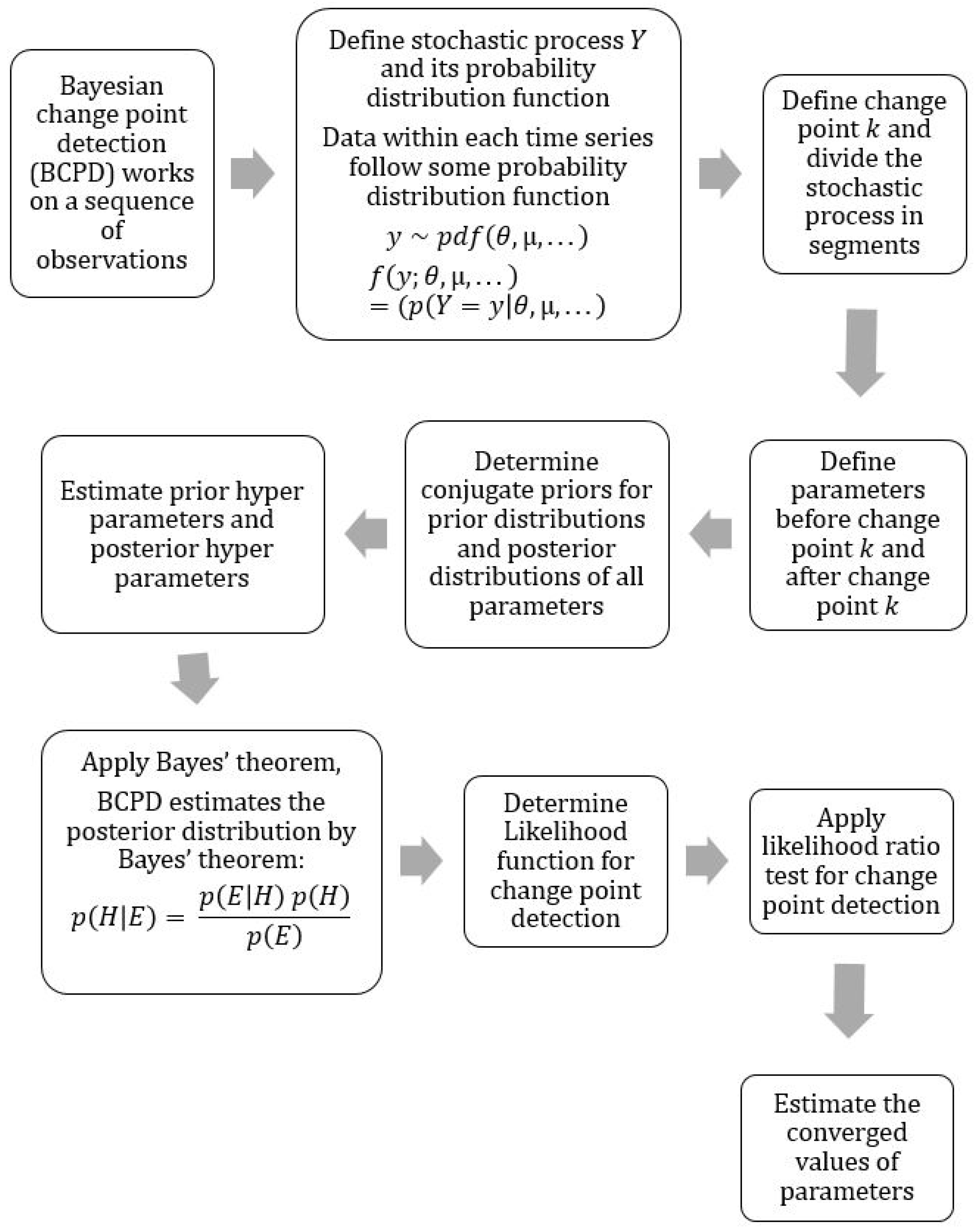



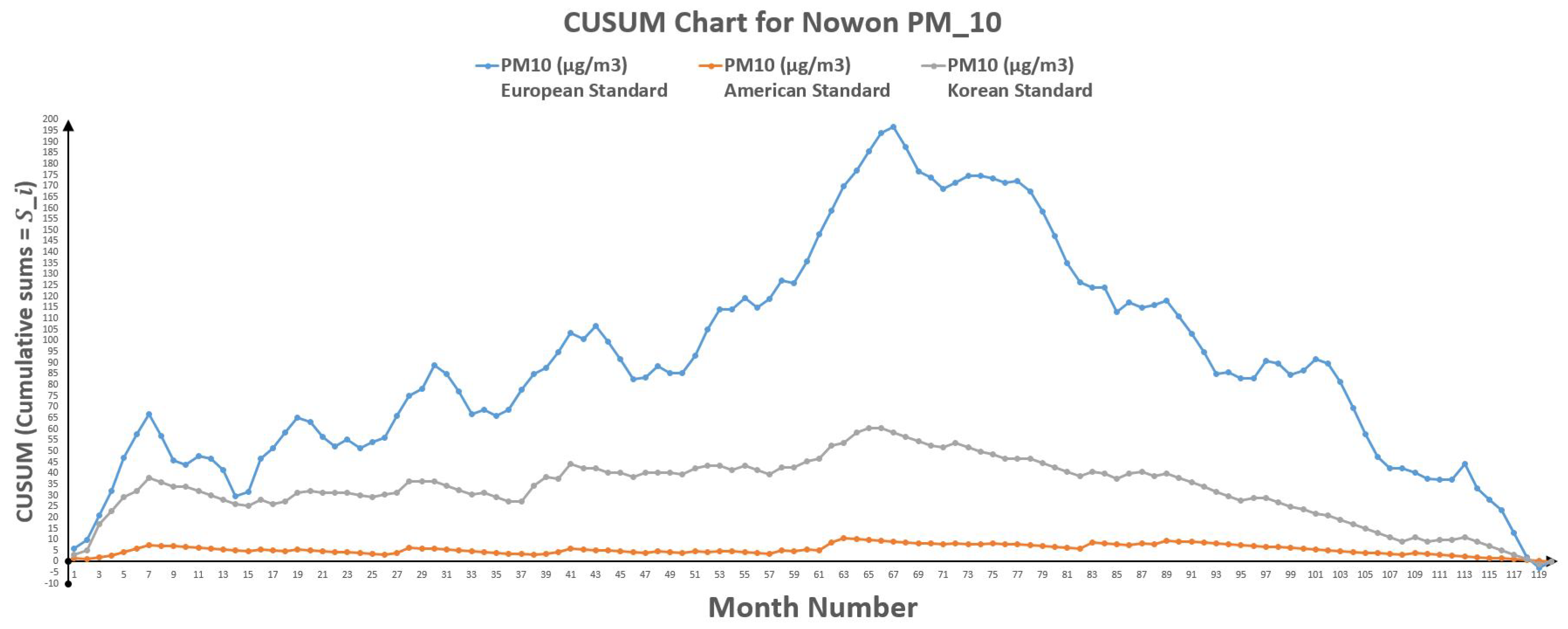
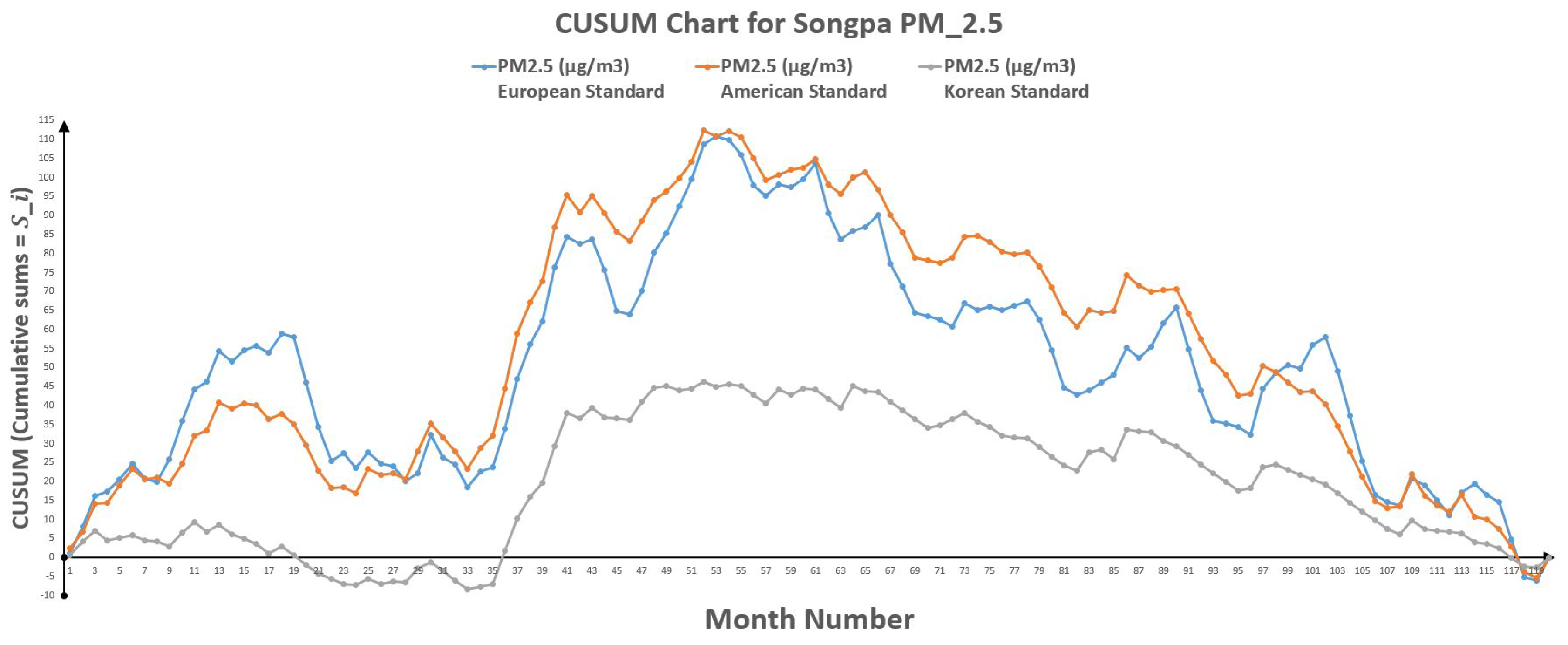

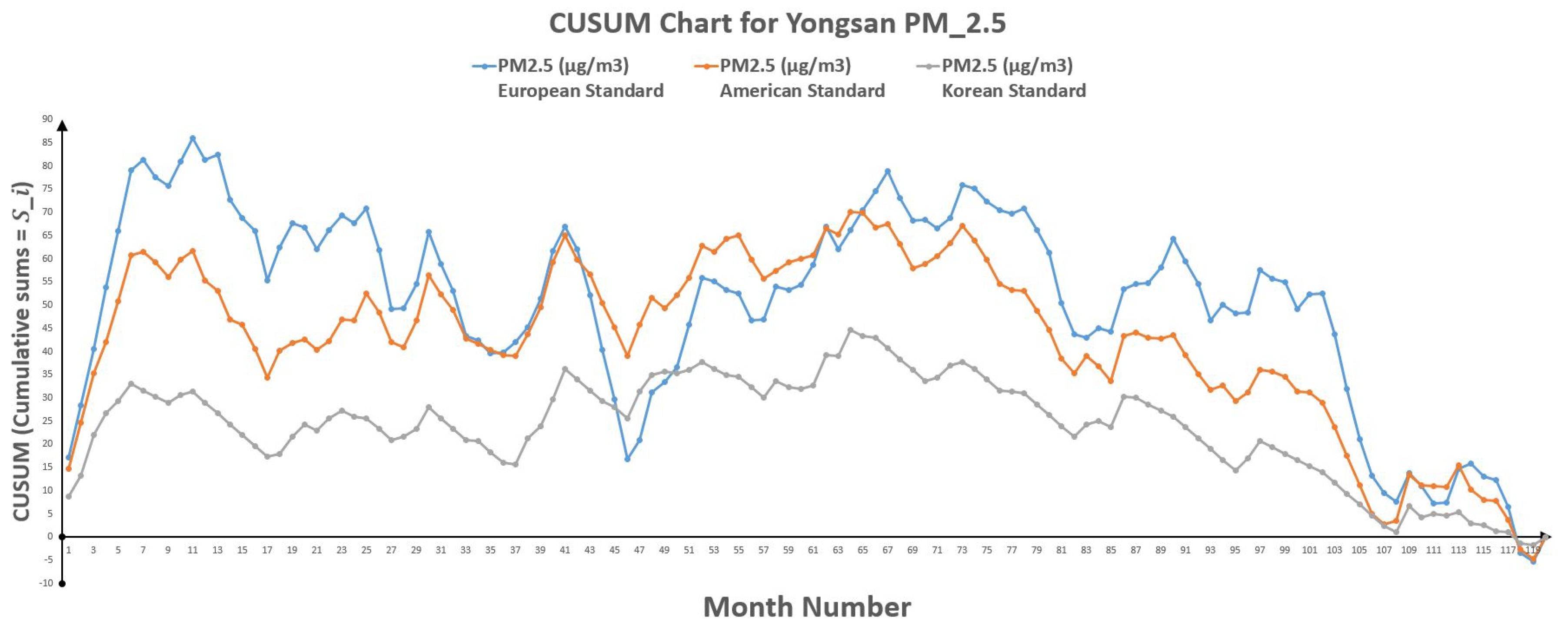

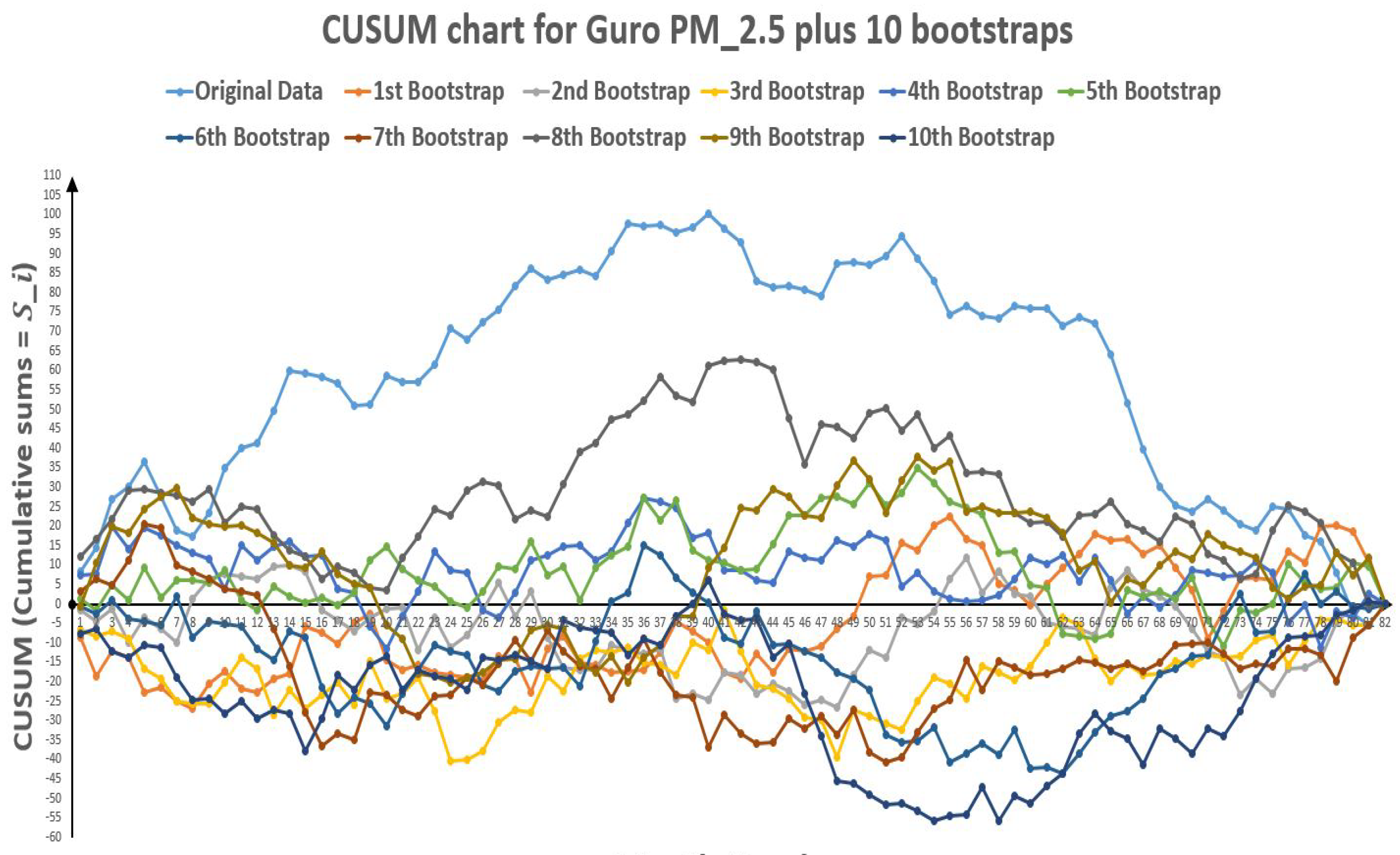
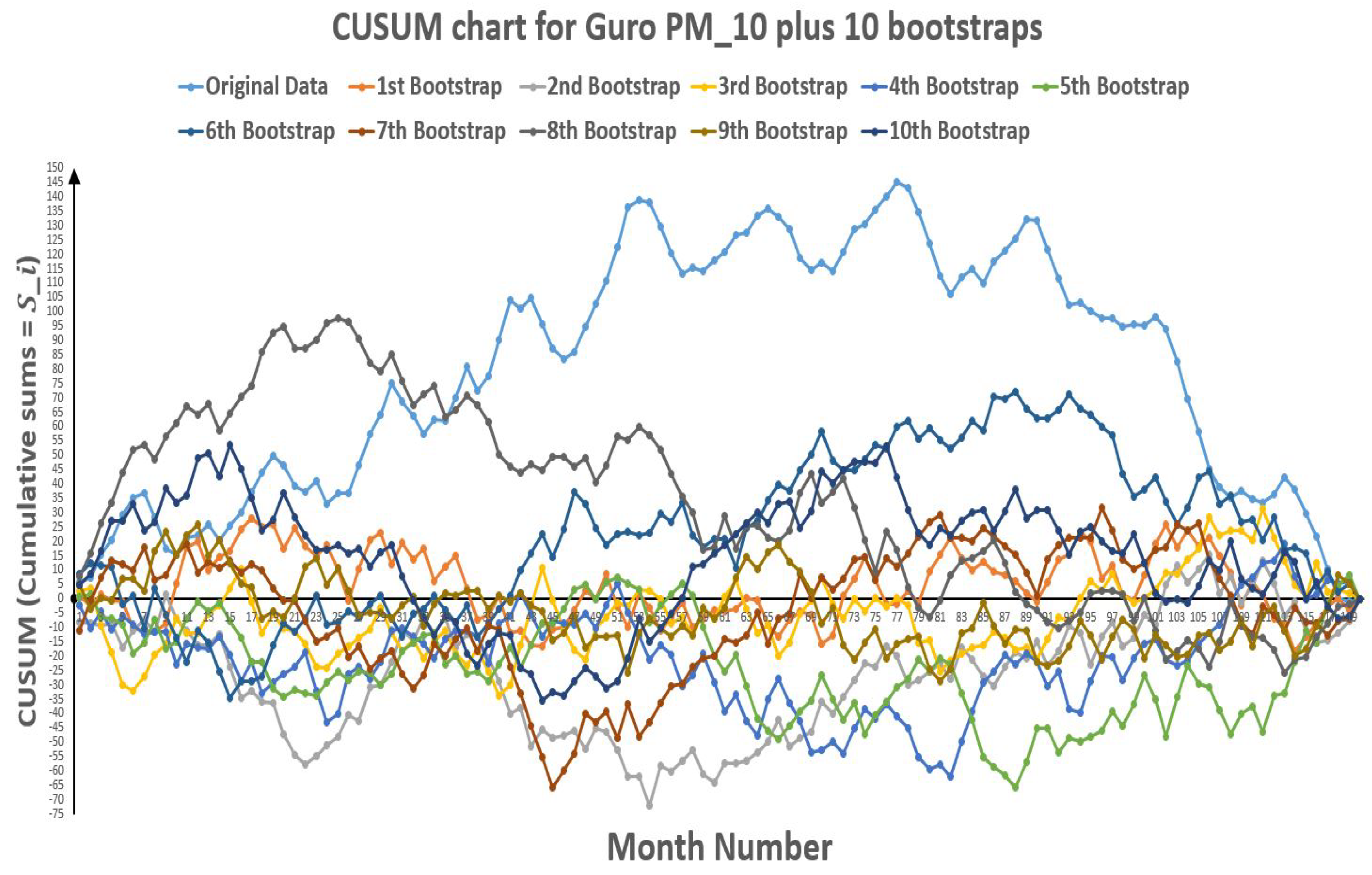
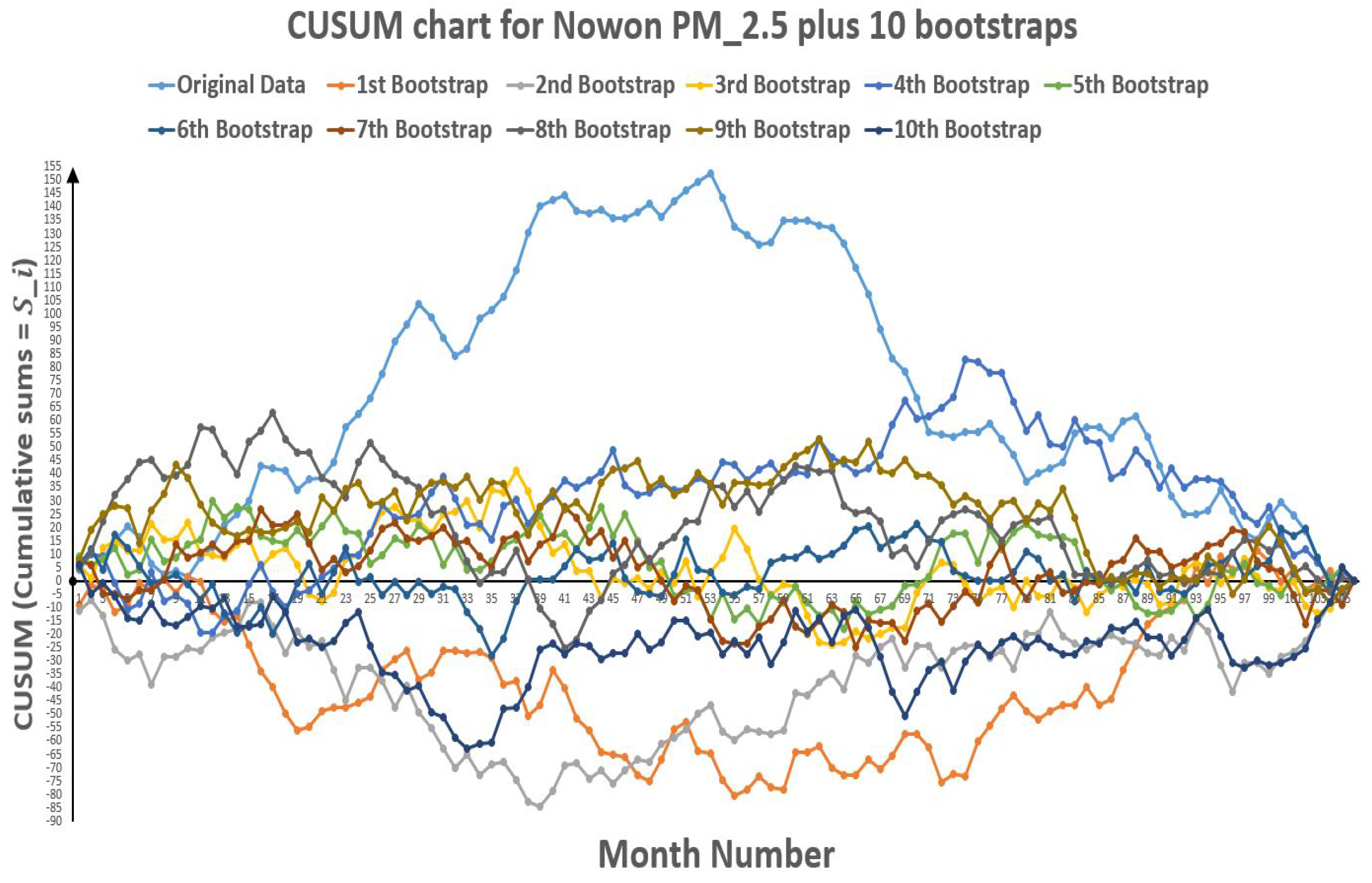
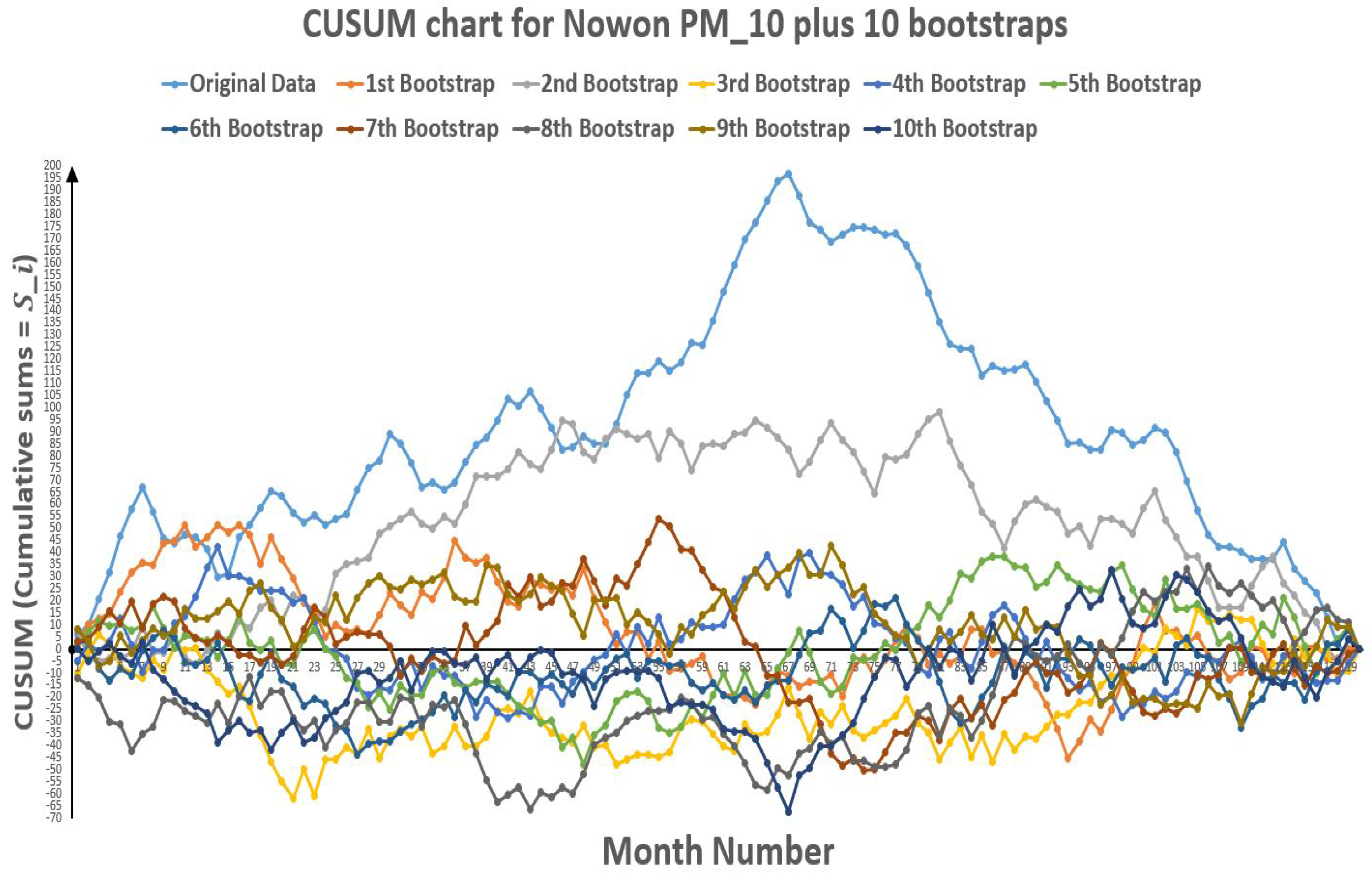
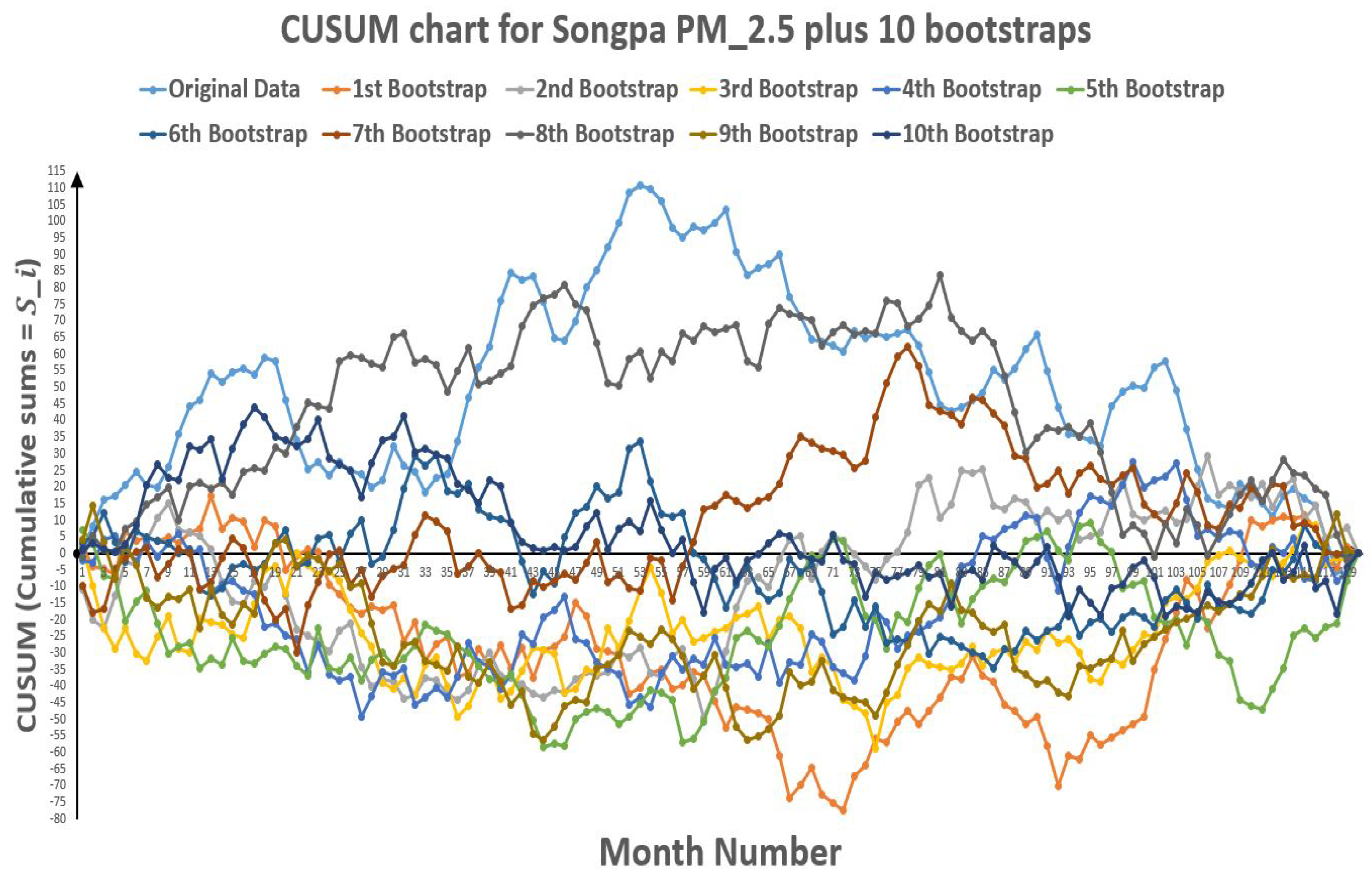

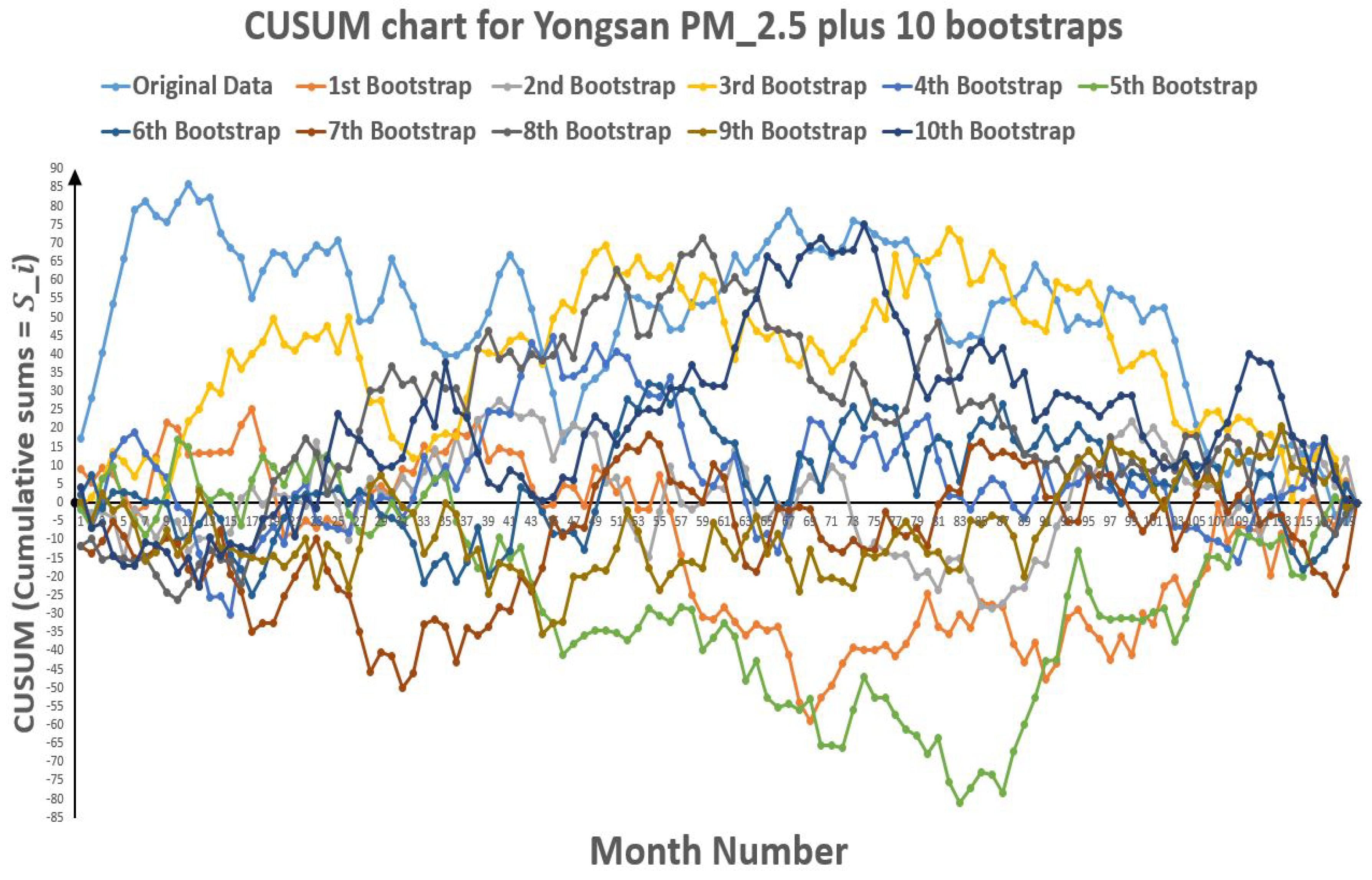


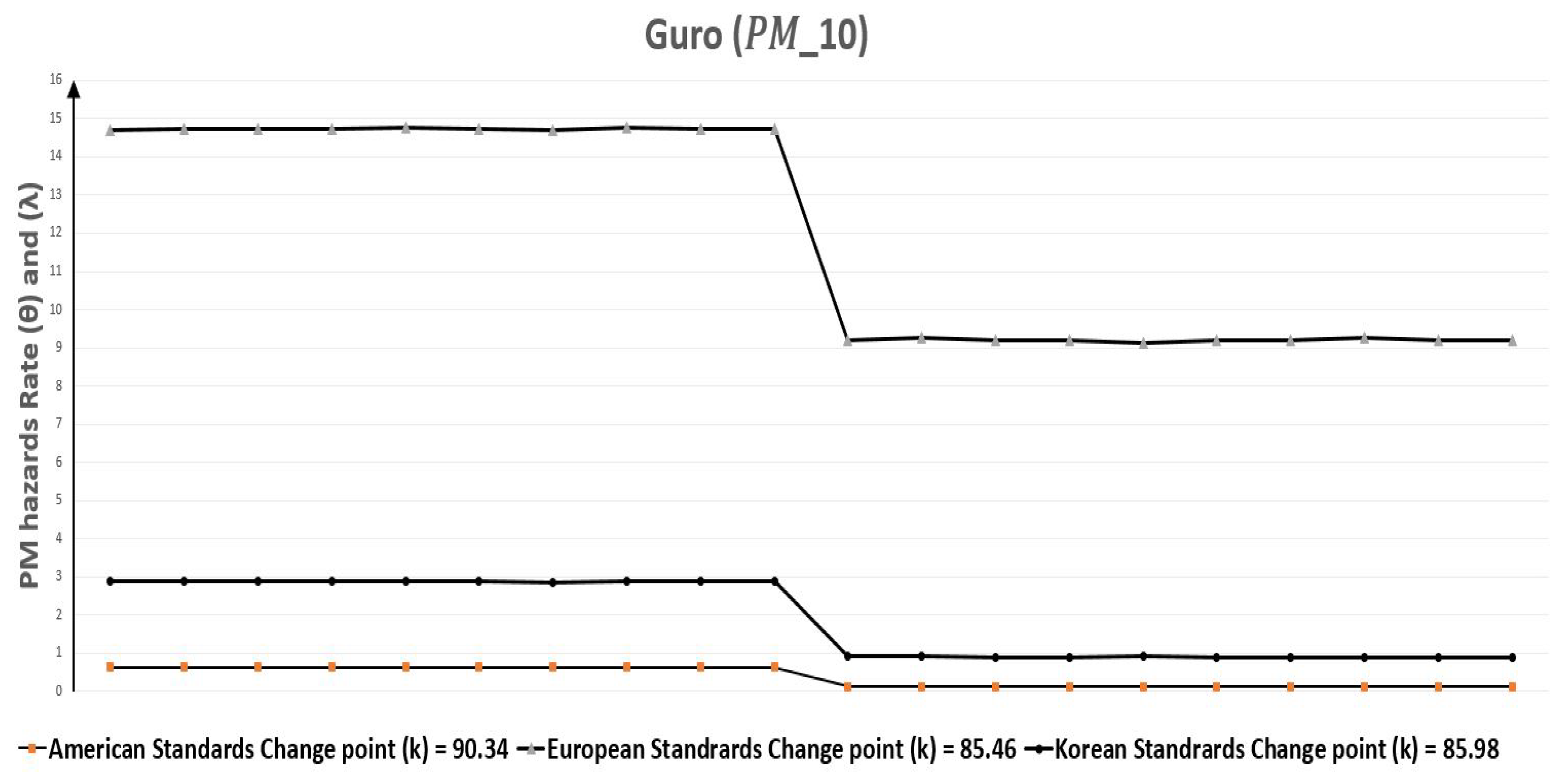
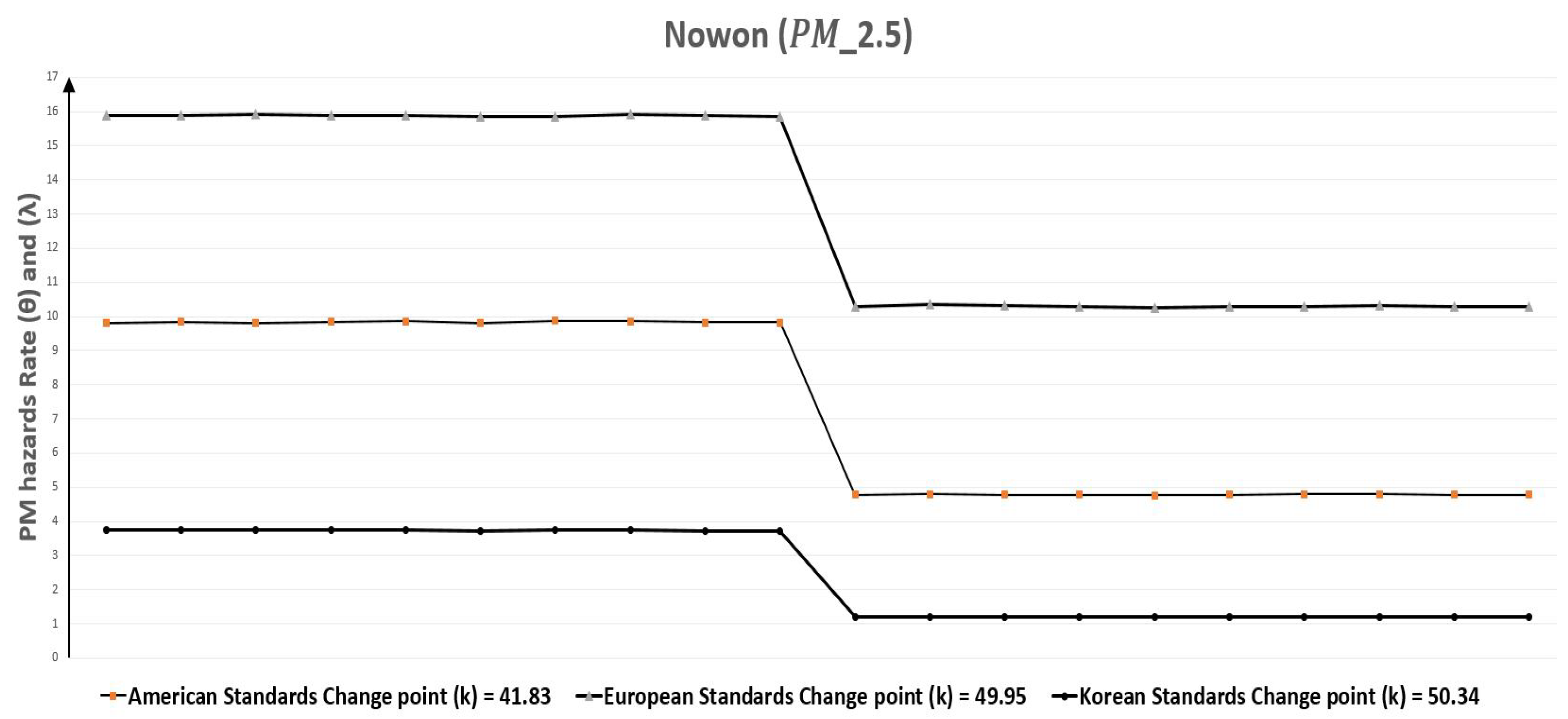



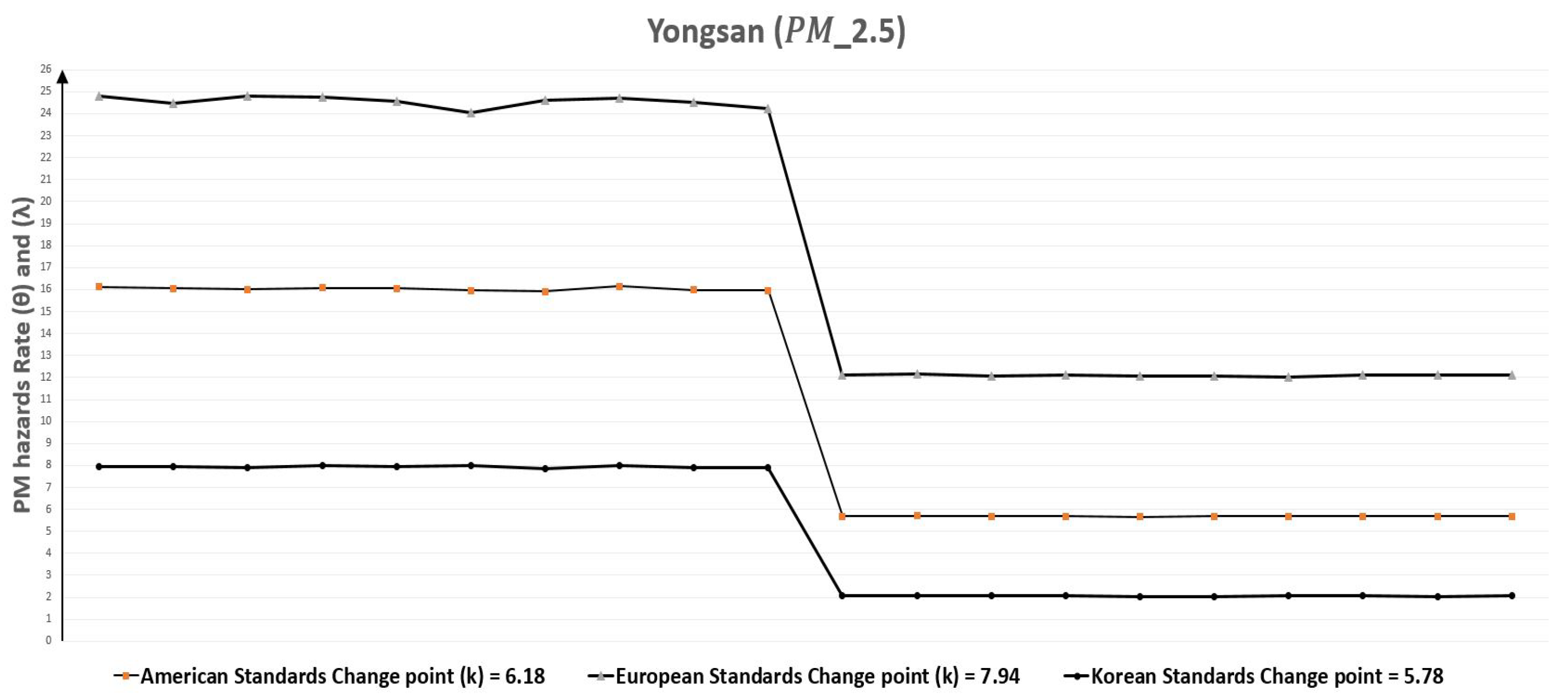

| Authors | Airborne Particulate Matters (, ) | Change-Point Detection | BCPD (Bayesian Change Point Detection) | Time Series Analysis |
|---|---|---|---|---|
| Lim et al. (2012) [28] | Ambient particulate matter (PM) | - | - | - |
| Rao et al. (2018) [29] | Particulate matter air pollution | - | - | - |
| Wei and Meng (2018) [30] | Airborne fine particulate matter () | - | - | - |
| Wang et al. (2017) [31] | Inhaled particulate matter | - | - | - |
| Heroux et al. (2015) [1] | Ambient air pollutants | - | - | - |
| Wellenius et al. (2012) [32] | Ambient Air Pollution | - | - | - |
| Pirani et al. (2015) [4] | Airborne particles | - | - | Bayesian inference within Time series |
| Li et al. (2013) [33] | Airborne particulate matter | - | - | Time series analysis |
| Kim et al. (2018a) [34] | Particulate matter | - | - | - |
| Kim et al. (2017) [35] | Air pollution | - | - | Time series model |
| Qin et al. (2017) [36] | Air pollution | - | - | Time series analysis |
| Lee et al. (2015) [37] | Fine and coarse particles | - | - | Time series analysis |
| Cabrieto et al. (2018) [38] | - | kernel change point detection, correlation changes | - | - |
| Keshavarz et al. (2018) [7] | Generalized likelihood ratio test, | - | - | |
| - | One-dimensional Gaussian process | - | - | |
| Kucharczyk et al. (2018) [8] | - | likelihood ratio test, | - | - |
| fractional Brownian motion | - | - | ||
| Lu et al. (2017) [9] | - | Change-point detection, machine monitoring, | - | - |
| Anomaly measure (AR model), Martingale test | Time series data | |||
| - | On-line change detection, | - | - | |
| Hilgert et al. (2016) [12] | - | autoregressive dynamic models, | - | - |
| - | CUSUM-like scheme | - | - | |
| Górecki et al. (2017) [13] | - | Change point detection, heteroscedastic, | - | Time series data |
| - | Karhunen-Loeve expansions | - | - | |
| - | Change point detection, bootstrap, | Time series data | ||
| Bucchia and Wendler (2017) [14] | - | Hilbert space valued random fields, | - | - |
| - | (Cramer–von Mises type test) | - | - | |
| Zhou et al. (2015) [16] | - | Sequential change point detection, | - | - |
| - | linear quantile regression models | - | - | |
| Lu and Chang (2016) [17] | - | Detecting change points, | - | - |
| - | mean/variance shifts, FCML-CP algorithm | - | - | |
| Liu et al. (2013) [11] | - | Change point detection, | Time series analysis | |
| - | relative density ratio estimation | - | - | |
| Ruggieri and Antonellis (2016) [19] | - | - | Bayesian sequential change point detection | - |
| Keshavarz and Huang (2014) [20] | - | - | Bayesian and Expectation Maximization methods, | |
| - | - | multivariate change point detection | - | |
| Kurt et al. (2018) [21] | - | - | Bayesian change point model, | - |
| - | - | SIP-based DDoS attacks detection | - | |
| - | - | Post classification change detection, | - | |
| Wu et al. (2017) [22] | - | - | iterative slow feature analysis, | - |
| - | - | Bayesian soft fusion | - | |
| Gupta and Baker (2017) [26] | - | - | Spatial event rates, change point, | |
| - | - | Bayesian statistics, induced seismicity | - | |
| Marino et al. (2017) [23] | - | - | Change point, multiple biomarkers, | - |
| - | - | ovarian cancer | - | |
| Jeon et al. (2016) [24] | - | - | Abrupt change point detection, | - |
| - | - | annual maximum precipitation, fused lasso | - | |
| Bardwell and Fearnhead (2017) [27] | - | - | Bayesian Detection, Abnormal Segments | Time series analysis |
| Chen et al. (2017) [25] | - | - | Bayesian change point analysis, | - |
| - | - | extreme daily precipitation | - | |
| This study | Airbone Particulate Matter | Change point detection | Bayesian approach and likelihood ratio test for change point detection | Time series data |
| Authors | Change-Point Detection |
|---|---|
| Cabrieto et al. (2018) [38] | Detection of correlation changes by applying kernel change point detection on the running correlations |
| Keshavarz et al. (2018) [7] | Detecting a change in the mean of one-dimensional Gaussian process data in the fixed domain regime based on the generalized likelihood ratio test (GLRT) |
| Kucharczyk et al. (2018) [8] | Variance change point detection for fractional Brownian motion based on the likelihood ratio test |
| Lu et al. (2017) [9] | Graph-based structural change detection for rotating machinery monitoring by martingale-test method |
| Hilgert et al. (2016) [12] | On-line change detection for uncertain autoregressive dynamic models through nonparametric estimation (CUSUM-like scheme) |
| Górecki et al. (2017) [13] | Change point detection in heteroscedastic time series through Karhunen-Loeve expansions |
| Bucchia and Wendler (2017) [14] | Change point detection and bootstrap for Hilbert space valued random fields (Cramer-von Mises type test) |
| Zhou et al. (2015) [16] | A method for sequential detection of structural changes in linear quantile regression models. |
| Lu and Chang (2016) [17] | Detecting change-points for shifts in mean and variance using fuzzy classification maximum likelihood change-point (FCML-CP) algorithm |
| Liu et al. (2013) [11] | Change point detection in time-series data by relative density-ratio estimation |
| This study | Change point detection for airborne particulate matter (, ) through Bayesian approach and likelihood ratio test |
| Authors | BCPD (Bayesian Change Point Detection) |
|---|---|
| Ruggieri and Antonellis (2016) [19] | A sequential Bayesian change point algorithm was proposed that provides uncertainty bounds on both the number and location of change points |
| Keshavarz and Huang (2014) [20] | Bayesian and Expectation Maximization (EM) methods for change point detection problem of multivariate data with both single and multiple changes |
| Kurt et al. (2018) [21] | A Bayesian change point model for detecting SIP-based DDoS attacks |
| Wu et al. (2017) [22] | A post-classification change detection method based on iterative slow feature analysis and Bayesian soft fusion |
| Gupta and Baker (2017) [26] | Estimating spatially varying event rates with a change point using Bayesian statistics: Application to induced seismicity |
| Marino et al. (2017) [23] | Change-point of multiple biomarkers in women with ovarian cancer |
| Jeon et al. (2016) [24] | Abrupt change point detection of annual maximum precipitation through fused lasso penalty function by using the Generalized Extreme Value (GEV) distribution |
| Bardwell and Fearnhead (2017) [27] | Bayesian Detection of Abnormal Segments in Multiple Time Series |
| Chen et al. (2017) [25] | Bayesian change point analysis for extreme daily precipitation |
| This study | Change point detection for airborne particulate matter (, ) through Bayesian approach and likelihood ratio test |
| Air Quality Standards for (g/m) | Air Quality Standards for (g/m) | ||
|---|---|---|---|
| European Standard () | 25 | European Standard () 24 h | 50 |
| American Standard () | 35 | American Standard () 24 h | 150 |
| Korean Standard () 24 h | 50 | Korean Standard () 24 h | 100 |
| Particle Pollution | Criteria (g/m) | Total Number of Days | Effective Readings | Dangerous Concentration | %Age against Total Days | %Age against Effective Readings |
|---|---|---|---|---|---|---|
| Guro’s data (Seoul, South Korea) | ||||||
| European Standard | 25 | 2498 | 2486 | 1125 | 45.04% | 45.25% |
| American Standard | 35 | 2498 | 2486 | 532 | 21.30% | 21.40% |
| Korean Standard | 50 | 2498 | 2486 | 207 | 8.29% | 8.33% |
| Nowon’s data (Seoul, South Korea) | ||||||
| European Standard | 25 | 3228 | 3031 | 1371 | 42.47% | 45.23% |
| American Standard | 35 | 3228 | 3031 | 718 | 22.24% | 23.69% |
| Korean Standard | 50 | 3228 | 3031 | 255 | 7.90% | 8.41% |
| Songpa’s data (Seoul, South Korea) | ||||||
| European Standard | 25 | 3653 | 3388 | 1547 | 42.35% | 45.66% |
| American Standard | 35 | 3653 | 3388 | 795 | 21.76% | 23.47% |
| Korean Standard | 50 | 3653 | 3388 | 281 | 7.69% | 8.29% |
| Yongsan’s data (Seoul, South Korea) | ||||||
| European Standard | 25 | 3653 | 3456 | 1537 | 42.08% | 44.47% |
| American Standard | 35 | 3653 | 3456 | 746 | 20.42% | 21.59% |
| Korean Standard | 50 | 3653 | 3456 | 280 | 7.66% | 8.10% |
| Particle Pollution | Criteria (g/m) | Total Number of Days | Effective Readings | Dangerous Concentration | %Age against Total Days | %Age against Effective Readings |
|---|---|---|---|---|---|---|
| Guro’s data (Seoul, South Korea) | ||||||
| European Standard | 50 | 3653 | 3540 | 1580 | 43.25% | 44.63% |
| American Standard | 150 | 3653 | 3540 | 60 | 1.64% | 1.69% |
| Korean Standard | 100 | 3653 | 3540 | 279 | 7.64% | 7.88% |
| Nowon’s data (Seoul, South Korea) | ||||||
| European Standard | 50 | 3653 | 3531 | 1444 | 39.53% | 40.89% |
| American Standard | 150 | 3653 | 3531 | 41 | 1.12% | 1.16% |
| Korean Standard | 100 | 3653 | 3531 | 239 | 6.54% | 6.77% |
| Songpa’s data (Seoul, South Korea) | ||||||
| European Standard | 50 | 3653 | 3467 | 1490 | 40.79% | 42.98% |
| American Standard | 150 | 3653 | 3467 | 50 | 1.37% | 1.44% |
| Korean Standard | 100 | 3653 | 3467 | 240 | 6.57% | 6.92% |
| Yongsan’s data (Seoul, South Korea) | ||||||
| European Standard | 50 | 3653 | 3508 | 1566 | 42.87% | 44.64% |
| American Standard | 150 | 3653 | 3508 | 60 | 1.64% | 1.71% |
| Korean Standard | 100 | 3653 | 3508 | 282 | 7.72% | 8.04% |
| Poisson Process (Rate) | ||||
|---|---|---|---|---|
| Area | Distribution | European Standards | American Standards | Korean Standards |
| Guro | Poisson | 13.720 | 6.488 | 2.524 |
| Nowon | Poisson | 12.934 | 6.774 | 2.406 |
| Songpa | Poisson | 12.892 | 6.625 | 2.342 |
| Yongsan | Poisson | 12.808 | 6.217 | 2.333 |
| Poisson Process (Rate) | ||||
|---|---|---|---|---|
| Area | Distribution | European Standards | American Standards | Korean Standards |
| Guro | Poisson | 13.167 | 0.500 | 2.325 |
| Nowon | Poisson | 12.033 | 0.342 | 1.992 |
| Songpa | Poisson | 12.417 | 0.417 | 2.000 |
| Yongsan | Poisson | 13.050 | 0.500 | 2.350 |
| Converged Values of Parameters (Bayesian Approach) | ||||||||||||
|---|---|---|---|---|---|---|---|---|---|---|---|---|
| Replication Mean | Guro | Nowon | Songpa | Yongsan | ||||||||
Replication Mean | Replication Mean | Replication Mean | Replication Mean | Replication Mean | Replication Mean | Replication Mean | Replication Mean | Replication Mean | Replication Mean | Replication Mean | Replication Mean | |
| European standards | ||||||||||||
| 15.96 | 11.17 | 43.29 | 15.88 | 10.30 | 49.98 | 14.93 | 11.24 | 53.69 | 24.80 | 12.13 | 6.92 | |
| 16.03 | 11.25 | 42.53 | 15.89 | 10.34 | 49.83 | 14.90 | 11.28 | 53.81 | 24.46 | 12.15 | 8.07 | |
| 16.00 | 11.18 | 43.12 | 15.90 | 10.32 | 49.76 | 14.91 | 11.25 | 53.92 | 24.81 | 12.07 | 7.49 | |
| 16.01 | 11.17 | 43.19 | 15.90 | 10.30 | 49.96 | 14.91 | 11.24 | 54.05 | 24.77 | 12.14 | 7.75 | |
| 15.98 | 11.12 | 43.52 | 15.88 | 10.26 | 50.13 | 14.93 | 11.23 | 53.59 | 24.56 | 12.09 | 7.48 | |
| 15.96 | 11.14 | 43.61 | 15.87 | 10.28 | 50.12 | 14.89 | 11.24 | 53.98 | 24.07 | 12.08 | 9.48 | |
| 15.95 | 11.17 | 43.41 | 15.84 | 10.30 | 50.12 | 14.88 | 11.26 | 53.91 | 24.61 | 12.03 | 8.20 | |
| 16.04 | 11.21 | 42.76 | 15.94 | 10.34 | 49.65 | 14.93 | 11.26 | 53.73 | 24.69 | 12.13 | 7.87 | |
| 16.01 | 11.19 | 42.75 | 15.88 | 10.30 | 49.78 | 14.90 | 11.24 | 53.71 | 24.50 | 12.10 | 7.83 | |
| 15.96 | 11.15 | 43.59 | 15.85 | 10.30 | 50.23 | 14.88 | 11.25 | 54.07 | 24.23 | 12.12 | 8.30 | |
| Mean of 10 replications | 15.99 | 11.17 | 43.18 | 15.88 | 10.30 | 49.95 | 14.90 | 11.25 | 53.85 | 24.55 | 12.10 | 7.94 |
| American standards | ||||||||||||
| 8.35 | 5.32 | 33.46 | 9.82 | 4.77 | 42.11 | 8.73 | 4.95 | 53.32 | 16.12 | 5.69 | 6.17 | |
| 8.24 | 5.33 | 33.67 | 9.84 | 4.80 | 41.76 | 8.72 | 4.96 | 53.31 | 16.04 | 5.71 | 6.17 | |
| 8.22 | 5.30 | 34.31 | 9.82 | 4.78 | 42.12 | 8.72 | 4.95 | 53.35 | 16.00 | 5.69 | 6.21 | |
| 8.29 | 5.30 | 34.10 | 9.84 | 4.79 | 41.75 | 8.72 | 4.95 | 53.32 | 16.08 | 5.68 | 6.18 | |
| 8.31 | 5.30 | 33.49 | 9.86 | 4.77 | 41.67 | 8.72 | 4.93 | 53.32 | 16.05 | 5.67 | 6.17 | |
| 8.27 | 5.31 | 33.70 | 9.80 | 4.77 | 42.11 | 8.71 | 4.94 | 53.39 | 15.96 | 5.68 | 6.20 | |
| 8.24 | 5.30 | 34.01 | 9.88 | 4.79 | 41.66 | 8.70 | 4.95 | 53.33 | 15.92 | 5.69 | 6.19 | |
| 8.25 | 5.32 | 33.70 | 9.86 | 4.80 | 41.61 | 8.74 | 4.96 | 53.25 | 16.16 | 5.69 | 6.16 | |
| 8.47 | 5.33 | 32.46 | 9.83 | 4.78 | 41.66 | 8.72 | 4.94 | 53.21 | 15.99 | 5.68 | 6.16 | |
| 8.38 | 5.33 | 33.28 | 9.82 | 4.79 | 41.89 | 8.71 | 4.95 | 53.42 | 15.96 | 5.69 | 6.21 | |
Mean of 10 replications | 8.30 | 5.31 | 33.62 | 9.84 | 4.78 | 41.83 | 8.72 | 4.95 | 53.32 | 16.03 | 5.69 | 6.18 |
| Korean standards | ||||||||||||
| 3.58 | 1.63 | 38.14 | 3.75 | 1.21 | 50.29 | 3.13 | 1.64 | 56.57 | 7.95 | 2.05 | 5.80 | |
| 3.57 | 1.65 | 37.90 | 3.74 | 1.22 | 50.25 | 3.15 | 1.65 | 56.26 | 7.95 | 2.06 | 5.76 | |
| 3.58 | 1.64 | 37.97 | 3.75 | 1.21 | 50.23 | 3.15 | 1.64 | 56.34 | 7.92 | 2.05 | 5.80 | |
| 3.57 | 1.62 | 38.40 | 3.74 | 1.20 | 50.43 | 3.15 | 1.63 | 56.54 | 8.01 | 2.06 | 5.77 | |
| 3.56 | 1.61 | 38.48 | 3.74 | 1.20 | 50.32 | 3.14 | 1.63 | 56.50 | 7.94 | 2.05 | 5.78 | |
| 3.55 | 1.62 | 38.63 | 3.73 | 1.20 | 50.52 | 3.13 | 1.63 | 56.87 | 7.97 | 2.04 | 5.77 | |
| 3.54 | 1.62 | 38.60 | 3.75 | 1.20 | 50.30 | 3.13 | 1.64 | 56.53 | 7.87 | 2.05 | 5.80 | |
| 3.59 | 1.64 | 37.93 | 3.75 | 1.21 | 50.27 | 3.16 | 1.64 | 56.08 | 7.98 | 2.06 | 5.78 | |
| 3.57 | 1.63 | 37.84 | 3.73 | 1.20 | 50.43 | 3.15 | 1.64 | 55.86 | 7.90 | 2.05 | 5.79 | |
| 3.55 | 1.62 | 38.69 | 3.73 | 1.21 | 50.36 | 3.13 | 1.63 | 56.86 | 7.90 | 2.05 | 5.79 | |
Mean of 10 replications | 3.56 | 1.63 | 38.26 | 3.74 | 1.21 | 50.34 | 3.14 | 1.64 | 56.44 | 7.94 | 2.05 | 5.78 |
| Converged Values of Parameters (Bayesian Approach) | ||||||||||||
|---|---|---|---|---|---|---|---|---|---|---|---|---|
| Replication Mean | Guro | Nowon | Songpa | Yongsan | ||||||||
Replication Mean | Replication Mean | Replication Mean | Replication Mean | Replication Mean | Replication Mean | Replication Mean | Replication Mean | Replication Mean | Replication Mean | Replication Mean | Replication Mean | |
| European standards | ||||||||||||
| 14.71 | 9.20 | 85.53 | 14.95 | 8.36 | 67.04 | 16.11 | 9.49 | 53.29 | 14.57 | 8.41 | 90.09 | |
| 14.75 | 9.27 | 85.10 | 14.93 | 8.39 | 67.10 | 16.08 | 9.52 | 53.30 | 14.57 | 8.50 | 89.53 | |
| 14.74 | 9.20 | 85.49 | 14.93 | 8.36 | 67.16 | 16.11 | 9.45 | 53.29 | 14.58 | 8.47 | 89.63 | |
| 14.75 | 9.19 | 85.47 | 14.93 | 8.35 | 67.17 | 16.08 | 9.47 | 53.52 | 14.57 | 8.39 | 90.16 | |
| 14.76 | 9.12 | 85.65 | 14.92 | 8.33 | 67.13 | 16.06 | 9.44 | 53.75 | 14.56 | 8.35 | 89.85 | |
| 14.72 | 9.18 | 85.59 | 14.91 | 8.35 | 67.20 | 16.06 | 9.47 | 53.43 | 14.54 | 8.42 | 89.98 | |
| 14.71 | 9.18 | 85.75 | 14.90 | 8.36 | 67.13 | 16.14 | 9.48 | 53.36 | 14.52 | 8.41 | 90.12 | |
| 14.77 | 9.25 | 85.07 | 14.96 | 8.37 | 67.05 | 16.08 | 9.39 | 53.93 | 14.61 | 8.51 | 89.23 | |
| 14.73 | 9.18 | 85.29 | 14.92 | 8.35 | 67.03 | 16.07 | 9.47 | 53.26 | 14.60 | 8.48 | 88.67 | |
| 14.72 | 9.19 | 85.67 | 14.91 | 8.37 | 67.16 | 16.03 | 9.46 | 53.91 | 14.53 | 8.39 | 90.18 | |
Mean of 10 replications | 14.73 | 9.20 | 85.46 | 14.93 | 8.36 | 67.12 | 16.08 | 9.46 | 53.50 | 14.56 | 8.43 | 89.74 |
| American standards | ||||||||||||
| 0.63 | 0.12 | 90.65 | 0.69 | 0.13 | 66.56 | 0.56 | 0.07 | 87.63 | 0.66 | 0.04 | 91.61 | |
| 0.63 | 0.12 | 90.76 | 0.63 | 0.11 | 72.52 | 0.55 | 0.07 | 89.08 | 0.66 | 0.04 | 91.33 | |
| 0.63 | 0.12 | 90.67 | 0.52 | 0.08 | 81.79 | 0.56 | 0.07 | 87.86 | 0.66 | 0.04 | 91.46 | |
| 0.63 | 0.12 | 90.34 | 0.53 | 0.09 | 81.32 | 0.57 | 0.07 | 86.80 | 0.66 | 0.04 | 91.41 | |
| 0.63 | 0.12 | 90.23 | 0.76 | 0.14 | 60.70 | 0.56 | 0.06 | 88.35 | 0.67 | 0.04 | 91.03 | |
| 0.63 | 0.12 | 90.48 | 0.52 | 0.08 | 81.91 | 0.56 | 0.07 | 87.98 | 0.66 | 0.04 | 91.50 | |
| 0.63 | 0.12 | 90.53 | 0.45 | 0.06 | 89.85 | 0.56 | 0.06 | 88.72 | 0.66 | 0.05 | 91.18 | |
| 0.63 | 0.12 | 90.63 | 0.82 | 0.15 | 56.42 | 0.56 | 0.09 | 88.73 | 0.66 | 0.04 | 91.11 | |
| 0.63 | 0.13 | 89.33 | 0.64 | 0.11 | 71.37 | 0.56 | 0.07 | 88.19 | 0.66 | 0.04 | 91.69 | |
| 0.64 | 0.12 | 89.79 | 0.59 | 0.11 | 75.61 | 0.56 | 0.07 | 88.26 | 0.66 | 0.04 | 91.29 | |
Mean of 10 replications | 0.63 | 0.12 | 90.34 | 0.62 | 0.11 | 73.80 | 0.56 | 0.07 | 88.16 | 0.66 | 0.04 | 91.36 |
| Korean standards | ||||||||||||
| 2.89 | 0.91 | 85.25 | 2.92 | 0.89 | 65.68 | 3.16 | 1.09 | 52.78 | 3.32 | 1.11 | 67.44 | |
| 2.90 | 0.92 | 85.17 | 2.91 | 0.89 | 65.67 | 3.17 | 1.10 | 52.65 | 3.33 | 1.13 | 66.93 | |
| 2.89 | 0.90 | 85.96 | 2.92 | 0.89 | 65.69 | 3.17 | 1.09 | 52.79 | 3.32 | 1.12 | 67.52 | |
| 2.88 | 0.88 | 86.67 | 2.91 | 0.88 | 65.69 | 3.17 | 1.09 | 52.83 | 3.30 | 1.08 | 68.72 | |
| 2.90 | 0.91 | 84.97 | 2.91 | 0.88 | 65.67 | 3.16 | 1.08 | 52.79 | 3.30 | 1.09 | 68.37 | |
| 2.88 | 0.89 | 86.13 | 2.91 | 0.88 | 65.72 | 3.16 | 1.09 | 52.75 | 3.27 | 1.06 | 69.89 | |
| 2.87 | 0.87 | 87.12 | 2.90 | 0.89 | 65.70 | 3.16 | 1.09 | 52.64 | 3.28 | 1.08 | 68.93 | |
| 2.89 | 0.89 | 86.14 | 2.92 | 0.88 | 65.67 | 3.18 | 1.09 | 52.59 | 3.33 | 1.12 | 67.09 | |
| 2.88 | 0.89 | 86.27 | 2.90 | 0.88 | 65.63 | 3.16 | 1.09 | 52.56 | 3.31 | 1.10 | 67.66 | |
| 2.88 | 0.90 | 86.17 | 2.90 | 0.89 | 65.74 | 3.15 | 1.09 | 53.15 | 3.30 | 1.10 | 68.08 | |
Mean of 10 replications | 2.89 | 0.90 | 85.98 | 2.91 | 0.89 | 65.68 | 3.16 | 1.09 | 52.75 | 3.31 | 1.10 | 68.06 |
| Bayesian Approach for Change Point Detection | |||||||||
|---|---|---|---|---|---|---|---|---|---|
| Area Seoul, South Korea | Rate before Change Point | Rate after Change Point | K Change Point | Convergence Parameter for | Variance for | Convergence Parameter for | Variance for | Convergence Parameter for K | Variance for K |
| European standards | |||||||||
| Guro | 15.99 | 11.17 | 43.18 | 1.000408 | 0.583 | 1.000719 | 0.541 | 1.000747 | 59.219 |
| Nowon | 15.88 | 10.30 | 49.95 | 0.999943 | 0.783 | 1.000094 | 0.472 | 1.000036 | 34.238 |
| Songpa | 14.90 | 11.25 | 53.85 | 1.000199 | 0.302 | 1.000007 | 0.180 | 1.000870 | 9.719 |
| Yongsan | 24.55 | 12.10 | 7.94 | 1.000898 | 21.961 | 1.000943 | 0.477 | 1.002031 | 90.053 |
| American standards | |||||||||
| Guro | 8.30 | 5.31 | 33.62 | 1.002540 | 1.064 | 1.000105 | 0.176 | 1.001256 | 75.773 |
| Nowon | 9.84 | 4.78 | 41.83 | 1.000595 | 0.296 | 1.000200 | 0.089 | 1.001159 | 13.007 |
| Songpa | 8.72 | 4.95 | 53.32 | 0.999857 | 0.172 | 0.999934 | 0.076 | 1.000255 | 2.395 |
| Yongsan | 16.03 | 5.69 | 6.18 | 0.999993 | 5.726 | 0.999956 | 0.101 | 1.000028 | 0.356 |
| Korean standards | |||||||||
| Guro | 3.56 | 1.63 | 38.26 | 1.000475 | 0.132 | 1.000439 | 0.052 | 1.000865 | 41.605 |
| Nowon | 3.74 | 1.21 | 50.34 | 0.999959 | 0.083 | 1.000377 | 0.025 | 0.999978 | 9.024 |
| Songpa | 3.14 | 1.64 | 56.44 | 1.000200 | 0.068 | 1.000144 | 0.031 | 1.000588 | 45.887 |
| Yongsan | 7.94 | 2.05 | 5.78 | 1.000136 | 1.498 | 1.000237 | 0.018 | 0.999780 | 0.339 |
| CUSUM Approach for Change Point Detection | |||||||||
|---|---|---|---|---|---|---|---|---|---|
| Area Seoul, South Korea | Average Rate before Change | Average Rate after Change | Last Point before Change | First Point after Change | Most Extreme Point | Highest Point in CUSUM | Lowest Point in CUSUM | Magnitude of Change | Confidence Level % |
| European standards | |||||||||
| Guro | 16.23 | 11.33 | 40 | 41 | 100.22 | 100.220 | −5.280 | 105.500 | 100% |
| Nowon | 15.81 | 10.06 | 53 | 54 | 152.50 | 152.500 | −3.066 | 155.566 | 100% |
| Songpa | 14.98 | 11.24 | 53 | 54 | 110.74 | 110.742 | −6.108 | 116.850 | 100% |
| Yongsan | 20.64 | 12.02 | 11 | 12 | 86.11 | 86.108 | −5.192 | 91.300 | 70% |
| American standards | |||||||||
| Guro | 8.14 | 5.20 | 36 | 37 | 59.44 | 59.439 | −5.024 | 64.463 | 100% |
| Nowon | 9.90 | 4.80 | 41 | 42 | 128.28 | 128.283 | −3.321 | 131.604 | 100% |
| Songpa | 8.79 | 4.97 | 52 | 53 | 112.50 | 112.500 | −5.375 | 117.875 | 100% |
| Yongsan | 7.31 | 4.96 | 64 | 65 | 70.13 | 70.133 | −4.783 | 74.917 | 100% |
| Korean standards | |||||||||
| Guro | 3.69 | 1.66 | 35 | 36 | 40.65 | 40.646 | −1.476 | 42.122 | 100% |
| Nowon | 3.76 | 1.20 | 50 | 51 | 67.72 | 67.717 | −5.217 | 72.934 | 100% |
| Songpa | 3.23 | 1.66 | 52 | 53 | 46.23 | 46.233 | −8.275 | 54.508 | 100% |
| Yongsan | 3.03 | 1.54 | 64 | 65 | 44.67 | 44.667 | −1.667 | 46.333 | 100% |
| Bayesian Approach for Change Point Detection | |||||||||
|---|---|---|---|---|---|---|---|---|---|
| Area Seoul, South Korea | Rate before Change Point | Rate after Change Point | K Change Point | Convergence Parameter for | Variance for | Convergence Parameter for | Variance for | Convergence Parameter for K | Variance for K |
| European standards | |||||||||
| Guro | 14.73 | 9.20 | 85.46 | 1.000072 | 0.425 | 1.000427 | 0.925 | 0.999931 | 64.845 |
| Nowon | 14.93 | 8.36 | 67.12 | 0.999879 | 0.464 | 0.999925 | 0.327 | 1.000040 | 3.184 |
| Songpa | 16.08 | 9.46 | 53.50 | 1.000300 | 0.643 | 1.001282 | 0.310 | 1.003363 | 9.133 |
| Yongsan | 14.56 | 8.43 | 89.74 | 1.000123 | 0.597 | 1.000437 | 1.492 | 1.001094 | 75.750 |
| American standards | |||||||||
| Guro | 0.63 | 0.12 | 90.34 | 0.999840 | 0.009 | 1.000320 | 0.005 | 1.002821 | 31.264 |
| Nowon | 0.62 | 0.11 | 73.80 | 1.041187 | 0.173 | 1.036355 | 0.011 | 1.053574 | 1089.508 |
| Songpa | 0.56 | 0.07 | 88.16 | 1.000135 | 0.016 | 1.000253 | 0.037 | 1.000710 | 174.232 |
| Yongsan | 0.66 | 0.04 | 91.36 | 0.999851 | 0.016 | 1.000296 | 0.004 | 1.000219 | 32.243 |
| Korean standards | |||||||||
| Guro | 2.89 | 0.90 | 85.98 | 1.000820 | 0.046 | 1.001576 | 0.053 | 1.003429 | 59.252 |
| Nowon | 2.91 | 0.89 | 65.68 | 0.999881 | 0.045 | 1.000137 | 0.016 | 1.000338 | 0.567 |
| Songpa | 3.16 | 1.09 | 52.75 | 0.999935 | 0.066 | 1.000075 | 0.017 | 1.001445 | 7.194 |
| Yongsan | 3.31 | 1.10 | 68.06 | 1.002209 | 0.077 | 1.003709 | 0.050 | 1.004787 | 81.344 |
| CUSUM Approach for Change Point Detection | |||||||||
|---|---|---|---|---|---|---|---|---|---|
| Area Seoul, South Korea | Average Rate before Change | Average Rate after Change | Last point before Change | First Point after Change | Most Extreme Point | Highest Point in CUSUM | Lowest Point in CUSUM | Magnitude of Change | Confidence Level % |
| European standards | |||||||||
| Guro | 15.05 | 9.79 | 77 | 78 | 145.17 | 145.167 | −0.833 | 146.000 | 100% |
| Nowon | 14.97 | 8.32 | 67 | 68 | 196.77 | 196.767 | −2.967 | 199.733 | 100% |
| Songpa | 16.15 | 9.46 | 53 | 54 | 197.92 | 197.917 | −1.583 | 199.500 | 100% |
| Yongsan | 15.01 | 9.53 | 77 | 78 | 151.15 | 151.150 | −1.950 | 153.100 | 100% |
| American standards | |||||||||
| Guro | 0.64 | 0.10 | 89 | 90 | 12.50 | 12.500 | −2.000 | 14.500 | 100% |
| Nowon | 0.51 | 0.16 | 63 | 64 | 10.48 | 10.475 | 0.000 | 10.475 | 80% |
| Songpa | 0.70 | 0.19 | 53 | 54 | 14.92 | 14.917 | −5.833 | 20.750 | 100% |
| Yongsan | 0.67 | 0.00 | 89 | 90 | 15.50 | 15.500 | −0.500 | 16.000 | 10% |
| Korean standards | |||||||||
| Guro | 3.20 | 1.32 | 64 | 65 | 56.20 | 56.200 | −0.675 | 56.875 | 100% |
| Nowon | 2.91 | 0.87 | 66 | 67 | 60.55 | 60.550 | −1.008 | 61.558 | 100% |
| Songpa | 3.19 | 1.09 | 52 | 53 | 62.00 | 62.000 | −4.000 | 66.000 | 100% |
| Yongsan | 3.39 | 1.16 | 64 | 65 | 66.60 | 66.600 | −0.650 | 67.250 | 100% |
© 2019 by the authors. Licensee MDPI, Basel, Switzerland. This article is an open access article distributed under the terms and conditions of the Creative Commons Attribution (CC BY) license (http://creativecommons.org/licenses/by/4.0/).
Share and Cite
Khan, M.R.; Sarkar, B. Change Point Detection for Airborne Particulate Matter (PM2.5, PM10) by Using the Bayesian Approach. Mathematics 2019, 7, 474. https://doi.org/10.3390/math7050474
Khan MR, Sarkar B. Change Point Detection for Airborne Particulate Matter (PM2.5, PM10) by Using the Bayesian Approach. Mathematics. 2019; 7(5):474. https://doi.org/10.3390/math7050474
Chicago/Turabian StyleKhan, Muhammad Rizwan, and Biswajit Sarkar. 2019. "Change Point Detection for Airborne Particulate Matter (PM2.5, PM10) by Using the Bayesian Approach" Mathematics 7, no. 5: 474. https://doi.org/10.3390/math7050474
APA StyleKhan, M. R., & Sarkar, B. (2019). Change Point Detection for Airborne Particulate Matter (PM2.5, PM10) by Using the Bayesian Approach. Mathematics, 7(5), 474. https://doi.org/10.3390/math7050474






